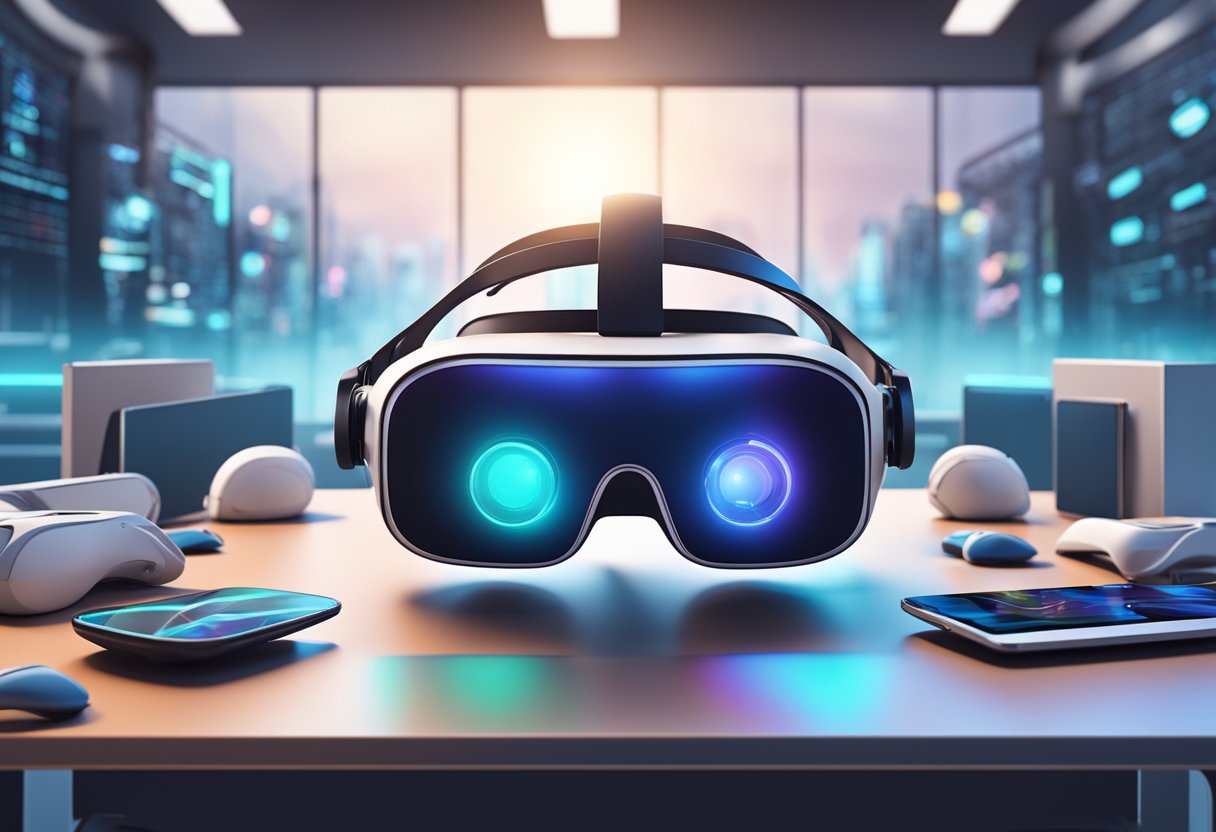Top Virtual Reality Headsets: A Comprehensive Guide to the Best Options in 2024
Virtual reality (VR) has transformed how people experience digital content, from gaming to educational applications. Today’s top virtual reality headsets provide immersive experiences with advanced technology, making them accessible for both casual users and serious gamers. As VR continues to evolve, newer models offer enhanced comfort, improved graphics, and a broader range of applications, catering to various interests.

In this blog post, readers will discover the best virtual reality headsets available in 2024. From the Meta Quest 3, known for its performance and user-friendly design, to the high-end Apple Vision Pro, which integrates a wide array of iOS apps, there is a headset to fit every need. Exploring these options will help potential buyers identify which headset suits their gaming preferences, budget, and overall VR experience.
As virtual reality technology advances, understanding the key features and specifications becomes crucial. Selecting the right headset not only enhances enjoyment but also enriches the overall virtual experience.
Key Takeaways
- The latest VR headsets offer a range of features for different users.
- Comfort and performance are key factors in choosing a headset.
- The future of VR looks promising with ongoing advancements in technology.
Evolution of Virtual Reality
Virtual reality (VR) has changed significantly since its early beginnings. The journey started in the 1960s with The Sword of Damocles, invented by Ivan Sutherland. This device was the first head-mounted display, allowing users to see simple 3D shapes.
In 1962, Morton Heilig created the Sensorama, an early attempt to offer an immersive experience. It used a stereoscopic display, sound, and scents to engage multiple senses.
By the 2010s, VR technology became more accessible. Palmer Luckey developed the Oculus Rift, which paved the way for modern headsets. This prototype was made from common materials, demonstrating that VR was possible outside large labs.
The development of augmented reality (AR) and mixed reality (MR) has expanded the definition of immersive experiences. AR headsets overlay digital information onto the real world, enhancing the user’s environment.
The concept of the metaverse has emerged, blending VR and AR to create shared, virtual spaces for socializing and gaming. This evolution shows how technology continues to innovate, making immersive experiences more engaging and widespread.
These advancements reflect the growing interest in virtual environments, pushing boundaries for entertainment, education, and communication. The future of VR is bright with potential for even more innovative applications.
Understanding VR Headsets
Virtual reality headsets are essential for immersive experiences in gaming, training, and simulation. They come in various types with different features that impact performance and user experience.
Types of VR Headsets
There are two main types of VR headsets: standalone and tethered.
-
Standalone Headsets: These are self-contained devices with built-in processors and storage. They do not require a computer or console to operate. Examples include the Meta Quest series.
-
Tethered Headsets: These are connected to a PC or console for more processing power. They often provide better graphics and performance. The Valve Index and PlayStation VR2 are popular tethered options.
Each type has its benefits, depending on the user’s needs for mobility and performance.
Key Features to Consider
When selecting a VR headset, there are several important features to consider:
-
Field of View (FOV): This refers to how much the user can see while wearing the headset. A wider FOV enhances immersion.
-
Refresh Rate: A higher refresh rate, such as 120Hz, leads to smoother visuals and less motion sickness.
-
Display Type: Many headsets use OLED displays for vibrant colors and deep blacks.
-
Tracking System: Features like 6DoF (six degrees of freedom), hand tracking, and head tracking improve the interactive experience and realism.
-
Passthrough: This allows users to see their surroundings while still wearing the headset, promoting safety and convenience.
How VR Headsets Work
VR headsets create immersive environments using various technologies. They contain screens that display images for each eye, creating depth perception.
-
Tracking Sensors: These track the user’s movements in real-time. This includes head tracking and sometimes eye tracking for more precise interactions.
-
Audio Solutions: Many headsets include spatial audio to enhance realism. This makes sounds come from specific directions within the virtual space.
-
Input Methods: VR headsets often use controllers or hand tracking. This allows users to interact naturally with the virtual environment.
By combining these elements, VR headsets transport users into new worlds, making technology more immersive and engaging.
VR Hardware Overview
Virtual reality hardware comes in various forms, each with unique features and capabilities. Understanding the differences helps users choose the right headset for their needs.
Standalone VR Headsets
Standalone VR headsets are all-in-one devices that do not require a PC or console. They come with built-in displays and processing power, making them easy to set up and use.
The Meta Quest 2 is a well-known model, offering a balance of affordability and performance. Its successor, the Meta Quest 3, aims to enhance the user experience with improved graphics and tracking capabilities.
Another notable option is the Meta Quest Pro, which boasts advanced features suitable for professional use. These headsets are popular among those new to VR, as they require minimal hardware and provide a straightforward experience.
PC and Console VR Headsets
PC and console VR headsets offer high-quality graphics and performance, but they require external hardware. The Valve Index is highly regarded for its excellent tracking and display features.
HTC Vive Pro 2 is another premium choice, delivering stunning visuals and an immersive experience. It connects to a powerful gaming PC, which allows for more detailed graphics than standalone options.
The PlayStation VR and its successor, PlayStation VR2 (PSVR 2), are tailored for console gamers. The PSVR 2 features enhanced resolution and tracking, providing a more immersive experience within the PlayStation ecosystem.
Mobile VR Headsets
Mobile VR headsets use smartphones for display and processing. They are often more affordable but have limitations compared to standalone or PC units.
Devices like the Samsung Gear VR and Google Cardboard include basic mobile experiences, allowing users to enjoy VR content on the go.
Although these headsets are convenient, the experience is typically less immersive. The graphics depend on the smartphone used, which can restrict the quality of the virtual environment. Mobile VR is best for casual users or those looking to explore VR without significant investment.
Top Virtual Reality Headsets
Virtual reality headsets have transformed how users experience digital content. From gaming to mixed reality applications, there are options for every need and budget. This section explores the best VR headsets in different categories, highlighting what makes each of them stand out.
Best Overall VR Headsets
The Meta Quest 3 is often considered the best overall VR headset due to its blend of performance and features. It offers high-resolution displays and spatial audio, making it great for immersive experiences.
Another strong contender is the Apple Vision Pro. This headset focuses on mixed reality, allowing users to interact with both virtual and real-world elements. With a sleek design and advanced technology, it appeals to creative professionals.
Lastly, the Valve Index VR Kit stands out for its exceptional hand-tracking and field of view. It is a high-quality choice for serious gamers looking for detailed graphics and responsive controls.
Gaming-Focused VR Headsets
For gaming enthusiasts, the PlayStation VR2 is a top choice. It is compatible with a wide range of VR games and offers impressive graphics and haptic feedback, providing a more engaging gameplay experience.
Another noteworthy option is the HTC Vive XR Elite. This headset offers both wired and wireless options, making it versatile for various gaming setups. With a solid library of VR games, it remains popular among gamers.
The Meta Quest Pro also deserves mention for its focus on performance and comfort during long gaming sessions. With enhanced processing power, it handles demanding VR games smoothly.
Best Budget VR Headsets
For those on a budget, the Meta Quest 2 is a reliable option. It provides a solid entry point into virtual reality with a large library of accessible games. Its wireless capabilities make it convenient for new users.
The Oculus Go is another affordable choice. It is designed for casual users who want a straightforward VR experience without the need for additional equipment.
Finally, the Samsung Gear VR is accessible for those who already own compatible Samsung smartphones. It allows users to enjoy VR content at a lower price point while still delivering decent performance.
Specialized VR Uses
Virtual reality (VR) has many specialized applications beyond gaming. These uses span professional environments, education, and social interactions. Each area showcases VR’s ability to create immersive experiences with virtual objects and environments.
VR for Professional and Enterprise Applications
In the business world, VR plays a significant role in enhancing productivity and collaboration. Companies use VR for training simulations, allowing employees to practice real-world tasks in a safe environment. This method reduces costs and risks associated with on-the-job training.
Tools like Microsoft HoloLens and Magic Leap One provide spatial computing capabilities. Users can interact with virtual objects in their physical spaces, making it easier to visualize complex data. Industries like healthcare utilize VR for surgical training, enabling doctors to practice in lifelike scenarios.
Educational and Training Purposes
Education has seen a transformative impact from VR technology. Schools and universities use VR to create engaging learning environments. Students can explore historical sites or conduct scientific experiments without leaving the classroom.
VR platforms like Roblox also allow users to create educational content. Immersive experiences help students grasp difficult concepts through gameplay. Training modules simulate real-life challenges, improving skill retention and application.
Social and Entertainment Use
VR has significantly changed how people interact socially and enjoy entertainment. Platforms like VRChat and Meta Horizon facilitate virtual meetings and socializing. Users can create avatars and partake in activities together, regardless of physical distance.
Content creators and vtubers leverage VR to enhance their live streams and gaming experiences. They utilize mixed reality to merge their digital personas with the real world. This innovation boosts engagement, providing viewers with unique interactive experiences.
Design and Comfort
When choosing a virtual reality headset, design and comfort are crucial factors. A headset should fit well and feel comfortable during extended use.
The Meta Quest 3 stands out with its sleeker design. It has a lightweight frame that makes it more comfortable for long gaming sessions. Users appreciate its improved haptic feedback, which adds to the immersive experience by providing realistic sensations during gameplay.
Comfort features can vary between headsets. Some models include adjustable straps and cushioning. This helps ensure a secure fit without causing discomfort.
High-end models like the Apple Vision Pro offer premium materials and a refined design. This focus on comfort enhances the overall immersion. Players can enjoy long hours of gameplay without feeling fatigued.
Valve Index, another notable headset, has customizable sizing options. Users can tailor the fit to their head shape, improving comfort and stability.
In summary, a comfortable design contributes greatly to the immersive gaming experience. Enhanced haptic feedback and thoughtful ergonomics play a role in keeping users engaged in their virtual worlds. Choosing a headset that balances design and comfort ensures a satisfying VR journey.
Technology and Performance
Virtual reality headsets rely on advanced technology for an immersive experience. High resolution is crucial, as it enhances visual clarity. For example, the Meta Quest 3 features a resolution of 2064 x 2208 per eye.
Powerful processors are essential for smooth performance. The Qualcomm Snapdragon XR2 and its successors, such as the XR2+ and Snapdragon XR2 Gen 2, offer significant improvements in processing power. These processors help in running complex applications and games without lag.
Passthrough cameras add another layer of functionality. They allow users to see their surroundings while wearing the headset, making navigation easier. This feature enhances safety and usability during VR sessions.
Motion tracking is vital for realism. 6DoF motion tracking provides accurate positioning, allowing users to move freely in a virtual space. This technology enhances gameplay and interaction, making it more enjoyable.
Headsets like the Meta Quest 3 use a combination of these technologies to provide an exceptional VR experience. With advanced specifications and features, modern headsets cater to both casual users and serious gamers. The blend of high-resolution displays and powerful processing creates a captivating virtual environment.
Accessories and Controllers
Choosing the right accessories and controllers can enhance the virtual reality experience significantly.
Best Controllers: Many headsets come with their own controllers. The Valve Index Controllers are known for their precise tracking and ease of use. They allow users to grab, throw, and interact naturally in VR.
Finger-Tracking Controllers: These controllers let users move their fingers freely. This feature adds realism to interactions in virtual environments. They can capture the subtle movements of a user’s hands.
Motion-Sensing Controllers: These controllers track movements in 3D space. They react to the user’s position, making the VR experience more immersive. Users can swing, point, or navigate with ease.
Gesture Controls: Some systems support gesture controls, enabling users to perform tasks using hand movements. This option can improve accessibility and comfort, making VR inviting for a wider audience.
Accessories
In addition to controllers, accessories can enhance the VR experience.
- Headset Skins: These protect and customize the appearance of the headset.
- Controller Grips: These improve comfort during long gaming sessions.
- Battery Packs: They ensure longer playtime, preventing interruptions.
Investing in quality accessories and controllers can make a significant difference in enjoying virtual reality.
Software and Ecosystem
The software and ecosystem surrounding virtual reality headsets play an essential role in user experience. Different headsets support various platforms and applications, shaping how users interact with virtual content.
Meta Quest 3 utilizes Meta’s ecosystem, which offers a wide range of games and applications. Users can access content through the Meta Store, designed to be user-friendly and immersive.
Sony’s PSVR 2 connects seamlessly with PlayStation 5, making it ideal for console gamers. Its library includes popular titles and exclusive games that utilize the console’s power.
The Apple Vision Pro runs on visionOS. This operating system allows access to thousands of iPad apps and features advanced capabilities for mixed reality experiences. The Vision Pro emphasizes integration with other Apple devices, creating a more connected environment.
SteamVR supports various headsets, enabling users to access a vast collection of VR games. This platform is known for its flexibility and broad compatibility, making it a favorite among PC gamers.
With the rise of AR glasses and smart glasses, the software landscape is evolving. These devices often aim for lighter applications and augmented reality experiences, blending the digital and physical worlds.
Each headset’s software ecosystem significantly affects its appeal. The right combination of hardware and software can lead to a more engaging and enjoyable virtual reality experience.
Future of VR
The future of virtual reality (VR) looks promising, with advancements in technology making experiences richer and more immersive. New headsets, like the Meta Quest 3, focus on enhancing visual quality and user comfort.
Key Trends in VR:
- Better Graphics: Higher resolutions and faster refresh rates will lead to clearer and smoother images. This improves realism in gaming and simulations.
- Augmented Reality (AR): Combining VR with AR will create hybrid experiences. Users can interact with virtual objects in the real world, expanding the possibilities for education and training.
- More Accessible Products: As technology matures, more consumer-friendly VR products will emerge. This includes more budget options that deliver quality experiences.
Future Headsets to Watch:
| Headset | Key Features |
|---|---|
| Meta Quest 3 | Dual LCD, high resolution, color pass-through |
| Valve Index | High refresh rate, excellent tracking |
| HP Reverb G2 | Focus on high-resolution visuals |
With these advancements, VR will see increased use in fields like education, healthcare, and entertainment. As VR becomes more integrated into everyday life, the way people interact with digital content will change significantly.
Frequently Asked Questions
Here are some common questions about virtual reality headsets. The information covers the latest advancements, factors for gaming, and consumer preferences.
What are the most advanced VR headsets available as of 2024?
As of 2024, the Meta Quest 3 stands out as the most advanced option, with high-resolution dual LCD displays and a refresh rate of up to 120Hz. The Apple Vision Pro is also noted for premium features that enhance the virtual experience.
What are the key factors to consider when choosing a VR headset for gaming?
When selecting a VR headset for gaming, users should consider display resolution, refresh rate, and comfort. A good battery life and headset weight are also important for extended play sessions. Compatibility with games and systems must not be overlooked.
Which VR headsets offer the best experience for watching movies?
Headsets like the Meta Quest 3 and the HTC Vive XR Elite provide immersive experiences for movie watching. Their high-resolution displays and wide field of view help create a cinematic atmosphere. Comfort is also key for long viewing periods.
How does the Meta Quest 3 compare to other leading VR devices on the market?
The Meta Quest 3 is often highlighted for its capabilities, which generally surpass those of the Quest 2 and other competitors. Features like improved display technology and processing power make it a strong contender among leading VR devices.
What price range should I expect when looking for a high-quality virtual reality headset?
High-quality VR headsets typically range from around $250 for entry-level models, like the Meta Quest 2, to over $1,000 for premium devices like the Apple Vision Pro. Budgeting based on desired features is crucial for potential buyers.
Which virtual reality headset models are the most popular among consumers today?
Currently, the Meta Quest 3 and the Meta Quest 2 are very popular among users. The HTC Vive XR Elite is also gaining attention for PC gaming. Consumer preferences tend to favor these models for their quality and usability.






Post Comment